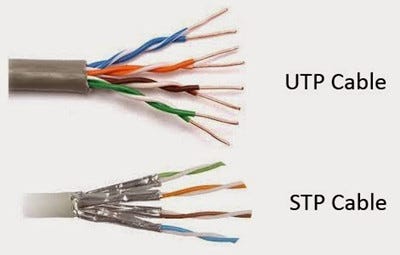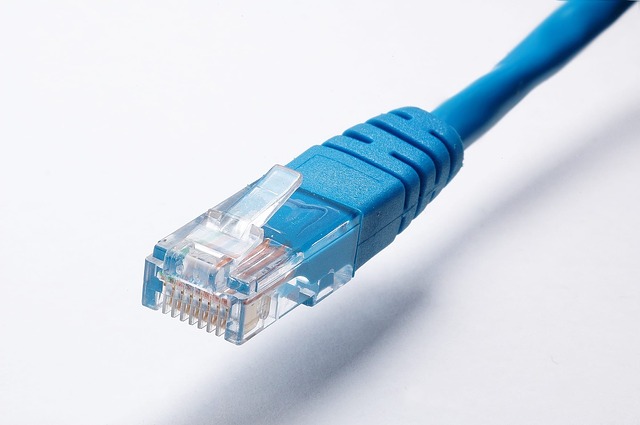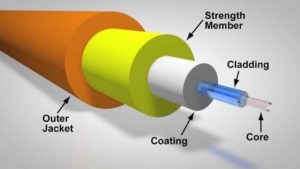Physical Media
Brief Definition
When data is sent from a source to some destination, it gets transmitted many times before reaching its destination. The data gets sent by the source and gets passed through several routers or other transmitter-receiver pairs before getting to its destination. Between those transmitter-receiver pairs, a medium helps connect pairs and transmit the data itself, and it's called Physical Media. Physical media have many forms and shapes, and it doesn't have to be the same physical media for a specific network. We're going to mention and explore some of the most used physical media in computer networking.[^1]
Twisted-Pair Copper Wire
The Twisted-Pair Copper Wire is the most widely used transmission medium. This may also be a result of how it is also the least expensive because of how copper can be found easily globally, which also makes it one of the cheaper metals available. The use of Twisted-Pair Copper Wire can be seen from telephones, as the landline telephone system uses them. The wires are about 1 mm thick and arranged in a regular spiral pattern.

The Twisted-Pair Copper Wire works by using signal wires. The signal wires put through changing electromagnetic fields will generate noise in the wire, as changing electromagnetic fields induce a voltage in a conductor. The reason for the wires themselves to be twisted around is to reduce electrical interference from outside sources. Each twist cancels out the noise by creating a voltage. Furthermore, suppose the electromagnetic field is still the same at the next twist. In that case, it will create a similar voltage with the opposite polarity, thus cancelling out the voltage in the previous twist.[^1]
There are two types of Twisted-Pair Copper Wires, likely:

Unshielded Twisted-Pair (UTP) Cable
The UTP cable is the most commonly used cable for local area networks (LANs). It is called "Unshielded" because it does not have any foil or braiding that would act as an insulator to protect it against interference. However, compared to other networking media, they are the most likely to cause electrical noise and interference. This makes the UTP cable more suited for areas with a lower degree of electromagnetic interference, such as domestic and office ethernet connections.[^4]
An example of the UTP cable is the CAT5 cable, which can be seen below

Shielded Twisted-Pair (STP) Cable
The STP cable is similar to the UTP cable, but it uses the shielding technique and combines them with the cancellation and wire twisting. It is called "Shielded" because each pair of wires is wrapped in a metallic foil. The foil functions to eliminate capacitive coupling, i.e., the transfer of energy within an electrical network or between distant networks utilizing displacement current between circuit(s) nodes, induced by the electric field (Capacitive coupling, 2019). In contrast, the twisting is used to eliminate inductive coupling, i.e., having a voltage induced because of the change of current through one wire, which generates a voltage across the ends of the other wire through electromagnetic induction (Inductive coupling, 2020). The STP cable is often used for equipment, racks, and buildings. Although STP cables have a better performance at a higher data rate and have better protection from interference than UTP, they are also more prominent and more expensive. This makes them harder to install and manufacture, as they are not suited for narrow spaces.[^4]
Coaxial-Cable
Coaxial cable is a type of cable that has an inner conductor surrounded by an insulating layer, surrounded by a conductive shielding. Like twisted pair, coaxial cable consists of two copper conductors, but the two conductors are concentric rather than parallel. With this construction and a special insulation and shielding, coaxial cable can have higher bit rates than twisted pair.[^6]
There are 2 varieties of coaxial cable. First, Baseband Coaxial Cable. Its a 50-ohm cable that is about a centimeter thick. This type is lightweight and durable, commonly used in LANS. The other one is called Broadband Coaxial Cable. Unlike the Baseband, this 75-ohm cable is quite thicker, heavier, and stiffer. It was commonly used in LANS before the baseband and now can be found on older installaments. Broadband cable, however, is quite common in cable television systems.
Fiber Optics
Fiber Optic is a flexible drawing glass or plastic that slightly thicker than a human hair. It gives out better transmission than a regular electrical cable because fiber optic can send out transmission over a longer distance. At higher bandwidths, it can achieve that because fiber has signals that travel through fiber has a lot less loss and fibers are immune to electromagnetic interference.
In a fiber optic cable, usually, there is more than one fiberglass. A fiber optic cable can have a few to a couple of hundred glasses. A fiber optic cable consists of 3 key parts: the core, which is the fiberglass, the cladding, which is another layer of glass used to protect the core, and the jacket, which acts as a final protective layer for each strand.

Fiber Optics works by transmitting the data in the form of light particles, then the fiber core and cladding each has their own refractive index, which will determine how the light will bend. When the light passes through the cable, the light reflection bounces to the core and cladding, which is a process called internal reflection. Sometimes, fiber optics still need help transmitting data, so fiber-optic transmissions sometimes require repeaters to regenerate the optical signal.
There are also several types of fiber optic cables, but there are only two primary types of fiber optic cable, which are Single-mode fiber and Multimode fiber. Single-mode fiber is usually used for longer distance transmissions because single-mode fiber has a lower possibility of attenuation, which is when signal strength is reduced due to the smaller diameter of the glass fiber core. The small size of the core also isolates the light into a single beam, making the route more direct and allowing for a longer travel distance. Single-mode also has considerably more bandwidth than multimode. While it doesn't have a longer travel distance, the multimode allows for more data transmission because the bigger diameter allows for multiple lights to be sent through the cable at once.[^2]
Terrestrial and Satellite Radio Channels
Radio Channels are very attractive media because it doesn't requires physical wire to be installed, can go through walls, provide connectivity to user, and can potentially carry a signal for long distances. Radio Channels carry signals in various bands in electromagnetic spectrum. The characteristics a radio channel depend significantly on the propagation environment and the distance over which a signal is to be carried. One of the example is interference by other radio channels.
Terrestrial radio channels can be classified into two groups: those that operate as local area networks(like WiFi) and wide-area radio channels that are used for mobile data services.
A communication satellite links two or more earth-based microwave transmitter/receivers, known as ground stations. The satellite receives transmissions on one frequency band, regenerates the signal using a repeater (discussed below), and transmits the signal on another frequency. Satellites can provide bandwidths in the gigabit per second range. Two types of satellites are used in communications: geostationary satellites and low-altitude satellites.[^1]
References
[^1]: Access Network and Physical Media by Keith W. Ross and Jim Kurose. Retrieved February 27 2021 from http://www2.ic.uff.br/~michael/kr1999/1-introduction/1_05-physical.htm/ [^2]: Fiber Optic by Jennifer English. Retrieved February 27 2021 from https://searchnetworking.techtarget.com/definition/fiber-optics-optical-fiber [^3]: Capacitive coupling. (2019, December 13). Wikipedia. https://en.wikipedia.org/wiki/Capacitive_coupling [^4]: fiberopticteresa. (2016, July 26). Twisted Pair Cable Overview. Medium. https://medium.com/@teresahuangting/twisted-pair-cable-overview-1bf0d9d674a8 [^5]: Inductive coupling. (2020, March 14). Wikipedia. https://en.wikipedia.org/wiki/Inductive_coupling [^6]: What is coaxial cable and how is it used?. Retrieved February 27 2021. https://www.ppc-online.com/blog/what-is-coaxial-cable-and-how-is-it-used